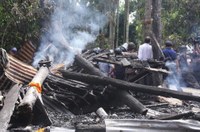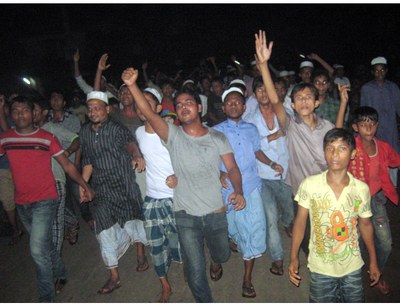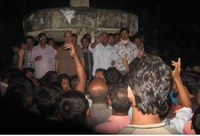A Statement by the Asian Human Rights Commission and Odhikar
 The entire governmental machinery of Bangladesh, with its retinue of law-enforcement units, intelligence agencies, and security forces, have totally and abysmally failed to protect minority communities in the South Eastern region of the country. A large number of monasteries, temples, houses and establishments of the Buddhist communities of the area, and even those belonging to some of the Hindu communities, have been subject to open arson and looting. Starting on September 29th, 2012 for 3 straight days the rampage continued in Cox’s Bazar and Chittagong districts. The devastating attacks began at Ramu sub-district town on the evening of 29th September and spread around the region in the following two days, virtually without even token measures by the authorities to protect the assets and trust of the affected communities. It is the local leaders of the ruling political party, in collusion with few leaders of other parties, along with locally known and unknown individuals, have been found to have provoked the hate-mongering and violence.
The entire governmental machinery of Bangladesh, with its retinue of law-enforcement units, intelligence agencies, and security forces, have totally and abysmally failed to protect minority communities in the South Eastern region of the country. A large number of monasteries, temples, houses and establishments of the Buddhist communities of the area, and even those belonging to some of the Hindu communities, have been subject to open arson and looting. Starting on September 29th, 2012 for 3 straight days the rampage continued in Cox’s Bazar and Chittagong districts. The devastating attacks began at Ramu sub-district town on the evening of 29th September and spread around the region in the following two days, virtually without even token measures by the authorities to protect the assets and trust of the affected communities. It is the local leaders of the ruling political party, in collusion with few leaders of other parties, along with locally known and unknown individuals, have been found to have provoked the hate-mongering and violence.
Victims and witnesses noted how local police acted as silent spectators to the firestorms lit up and fanned by the attackers. Bangladesh’s policing system has been conditioned to turn a blind eye to any violence orchestrated or committed by anyone having any connection to the ruling political parties. The police’s role, as silent spectator, further points a finger to the comprehensive culture of impunity for offenders having links to power, especially the ruling party.
Cox’s Bazar, like every district town, has a Police Line, accommodating reserve police forces, stationed there to tackle such violence. The Rapid Action Battalion (RAB), which is officially termed as an ‘elite force’, has a unit in every district headquarter to control ‘law and order.’ At least two battalions of the Border Guards Bangladesh (BGB) are stationed within half-an-hour driving distance from Cox’s Bazar and at Naikkhongchhari sub-district of Bandarban Hill district, which is adjacent to Ramu. Moreover, there is a military barrack within ten kilometers from Ramu town and an engineering core in Cox’s Bazar town. The authorities did not engage any of these agencies or forces in preventing the attacks before or after the incidents occurred.
It is evident that the country’s intelligence agencies failed to, or didn’t want to, predict the possibility of the attacks, even though profile government officials including the Prime Minister and Home Minister of Bangladesh termed the pillage as ‘pre-planned attacks.’ One of the glaring incidents in the series of attacks was the attack that took place at Paschim Marichchya Dipankar Buddha Bihar at Ukhia sub district, 24 hours after the attacks occurred at Ramu. The authorities did not take any effective measure to ensure security of the affected community in Ukhia area, although the events in Ramu had become known to the whole world through media by that time.
The people affected by the attacks are terrified, fearing this sort of attack might happen again. The witnesses and victims declined to expose their personal identity, due to the fear of further attack or harassment. Such apprehension reiterates the extreme necessity of an effective witness protection mechanism, something missing in Bangladesh. Hundreds of families are still homeless and living under imminent threat. An unknown number of victims have received various forms of injuries as a result of the multiple types of attacks. The Asian Human Rights Commission (AHRC) and Odhikar have not been able to ascertain whether the victims have been given access to adequate medical treatment facilities or not.
The police have been arresting people en-mass, without substantial evidence against the suspects. According to the police, at least 17 criminal cases have been registered with three police stations of Cox’s Bazaar and one police station of Chittagong district. the AHRC and Odhikar learned from the police officers of the relevant jurisdiction that 94 people have been arrested and detained by the police of Ramu pursuing eight related criminal cases filed with the police station. Two of these eight cases have been transferred to the Detective Branch (DB) of police, which has further arrested 30 more suspects, in Cox’s Bazaar. The police officers have denied disclosing the individual identities of the detained suspects, although they claim that the suspects belong to all major political parties including Awami League, BNP, Jatiya Party and Jamaat-E-Islami. They have confirmed that none of the detainees are from the Rohingya community.
Four cases have been registered with the Ukhia police, which has arrested 49 suspects. The police claim that few of the detained suspects are members of BNP and Jamaat-E-Islami. However, the officers refuse to reveal the details of the suspects or how the police have determined their involvement in the crimes. The Officer-in-Charge (OC) of Ukhia Police Station, Mr. Oppela Raju Naha said, “We are scrutinizing the suspects. No comments can be made while the matters are under investigation.”
Two cases have been registered with the Teknaf police, who have arrested at least 36 people as suspects. According to the Officer-in-Charge (OC) Md. Farhad Hossain, two of the detainees belong to the Jamaat-E-Islami, while none has yet been identified as Rohingya. He said, “More people might be arrested in the coming days in these cases.”
It has been learned from the Patiya police of Chittagong district that three cases have been registered with the police regarding the attacks in monasteries and temples within its jurisdiction. At least 35 people have been arrested and detained up to October 16th.
The political parties of Bangladesh have once again exposed their failure to face the gruesome truth. The ruling and opposition parties have been publicly playing their traditional blame-game against each other instead of addressing this unprecedented disaster to the country’s communal harmony. Both ruling and opposition politicians have failed to stand beside the victims, who deserve assurance from the larger powerful communities that recurrence of attacks would be prevented at any costs.
In principle, the AHRC and Odhikar are not publicizing the personal identity of the witnesses considering their security, as they have been under imminent threat and intimidation since the incidents occurred. This report wishes to expose the reality of the witnesses, who are under constant threat, with pseudonyms. The full report in both English and Bangla versions are available in the websites of both organizations.
A human rights fact-finding team visited the crime scenes between October 2nd and October 7th and documented the information through interviewing the victims cum eyewitnesses, leaders and supporters of different political parties and public officials including police and civil administration of the relevant jurisdictions. The AHRC and Odhikar are constantly monitoring the situation through the local contacts and through other modern communication system.
The fact-finding team learned from the witnesses in Cox’s Bazaar that the incident started at around 7.00 pm on September 29, 2012 following a post in a personal facebook account of a Buddhist young man named Mr. Uttam Kumar Barua, who is a resident of Baruapara at Ramu upazila of Cox’s Bazaar district. Another user had posted as a photo that allegedly insulted the Holy Quran, which was shown to be underneath a girl’s foot. And, this was tagged to Uttam’s personal facebook account.
The primary information obtained by the fact-finding mission was that the meetings and processions that took place before the attack on the homes and places of worship of the minority Buddhist and Hindu communities were led by the local leaders and activists of the Awami League. However, the local people said that during the attack, a few strangers were also seen along with those who were known. Many people said that kerosene and gunpowder were used during the attacks to start fires.
All of the local people were in shock, given that so many places of worship were being attacked at the same time. They had never witnessed such events before, and they could they imagine that such incidents could ever occur. Accurate information has not been found regarding exactly how the inflammable substances were used, collected, and who collected them. The gunpowder was of import. However, the alarming fact is that although several days have passed, the local authorities and intelligence agencies have yet to take any action. As a result, the feelings of insecurity among those affected by this attack have escalated.
During the fact-finding mission, it became clear that religious sentiment was used to mobilise a large number of people. It is believed that even though people from all faiths lived harmoniously in the past, the communal tension has now a tinderbox.
Whether the torture of the Rohingyas in Myanmar had any influence on these attacks was not the subject of this particular fact-finding mission. However, a social fact-finding mission and adequate explanation is required to understand the perspective mentioned above. It was clear that the people who gave information to the fact-finding team did not say anything about the Rohingyas being involved. Imaginary news about the Rohingyas being involved was released by some of the media.
The fact-finding team talked directly with the priests of the temples, the local people, and the members of law enforcement agencies. The result of these discussions was that the fact-finding team did not find any evidence regarding the involvement of the Rohingyas. Nonetheless, some media outlets have published news about a few Rohingyas being arrested and accused long before the incident took place. Attempts are being made to wrongly frame the Rohingyas. This is in order to hide the alleged involvement of the local Awami League leaders and activists, together with the massive, unpardonable, failure of the administration to act. In the context of the recent killings that have taken place in Myanmar, such misleading facts and unfair allegations may create dangerous impact for the Rohingyas in Myanmar and Bangladesh. Attempts might be made to arrest them in order to show that the Rohingyas were the instigators.
Instead of assuring a fair and proper investigation, the government is seen to be spending too much time in blaming their political opponents. Similarly, the opposition parties are busy criticizing the government instead of taking steps to gain the trust of the Buddhist and Hindu communities. The one and only political duty at this time should be in establishing good inter-community relations to ensure the security of the lives, belongings and places of worship of all the citizens of Bangladesh. The failure of the political parties in realizing the social and political consequences involved is a matter of grave concern. The government’s attempt to blame others instead of admitting their own faults makes the situation even more complicated.

A procession against the Buddhist community at about 8:30pm on 29 September at Ramu town. Mr. Saddam Hossain (wearing jeans pant and ash colour T-shirt), a leader of Bangladesh Chhatra League of Ramu, is seen at the central of the procession. On his right Mr. Hafez Mohammad (with a cap and black and grey stripe Punjabi), is a brother of a leader of Awami Jubo League.
According to information received, Mr. Ansarul (a.k.a Serajul) Haque Bhutto, President of the Bangladesh Awami Matsajibi (fisher folk) League of its Ramu upazila unit, who reportedly had a facebook-friendship with Uttam Kumar Barua, had observed the so called insulting photo tagged in Uttam’s account. Bhutto downloaded the photo in his cell phone and shared it with his friends in the same evening. The photo sparked anger among the recipients within about an hour.
Between 8:30 pm and 9:00 pm of 29th September a procession took to the street at Ramu upazila town. Mr. Ansarul Haque Bhutto was seen by the eye-witnesses at the head of the procession. This procession moved from street to street of Ramu. The participants appeared to be much agitated, chanting provocative slogans against the Buddhist community. Local eye-witnesses of the Buddhist community told the human rights fact-finding team of Odhikar that they saw Mr. Nurul Islam Salim, a secretary to the Chairman of the Cox’s Bazaar District Council and an active leader of the Awami Jubo League, youth wing of the ruling party Bangladesh Awami League, Mr. Azizul Haque, President of Awami Sechchhasebak [Volunteer] League Fotekharpul union unit, Mr. Nurul Islam, a lawyer by profession and also a Joint Secretary of the Bangladesh Awami League of the Cox’s Bazaar district unit, in the procession.
These leaders made speeches at the Choumuhuni of Ramu, i.e. the main square of the town, after a couple of rounds of the procession. The speakers demanded exemplary punishment for Uttam Kumar Barua for him insulting the Holy Quran. They announced a “hartal” [general strike] in Cox’s Bazaar on the following day, if Uttam was not arrested and punished by the authorities.
 The meeting was addressed by Mr. Ansarul Haque Bhutto, President of the Bangladesh Awami Matsojibi (fisher folk) League of it Ramu upazila unit; Mr. Nurul Islam Salim, a Secretary to the Chairman of the Cox’s Bazaar District Council and an active leader of the Awami Jubo League, youth wing of the ruling party Bangladesh Awami League; Mr. Azizul Haque, President of Awami Sechchhasebak [Volunteer] League Fotekharpul union unit; Mr. Nurul Islam, a lawyer by profession and also a Joint Secretary of the Bangladesh Awami League of the Cox’s Bazaar district unit; and Mr. Lutfor Rahman Kazal, Member of Parliament of Cox’s Bazaar-3 constituency and leader of the Bangladesh Nationalist Party (BNP) – the main opposition in the parliament. The speakers displayed a photo that allegedly insults the Holy Quran. (photo: A gathering where Mr. Lutfor Rahman Kazal, Member of Parliament of Cox’s Bazaar-3 constituency, is seen speaking. On his right hand side, Awami League leader Mr. Sohel Sarwar Kazal is seen standing.)
The meeting was addressed by Mr. Ansarul Haque Bhutto, President of the Bangladesh Awami Matsojibi (fisher folk) League of it Ramu upazila unit; Mr. Nurul Islam Salim, a Secretary to the Chairman of the Cox’s Bazaar District Council and an active leader of the Awami Jubo League, youth wing of the ruling party Bangladesh Awami League; Mr. Azizul Haque, President of Awami Sechchhasebak [Volunteer] League Fotekharpul union unit; Mr. Nurul Islam, a lawyer by profession and also a Joint Secretary of the Bangladesh Awami League of the Cox’s Bazaar district unit; and Mr. Lutfor Rahman Kazal, Member of Parliament of Cox’s Bazaar-3 constituency and leader of the Bangladesh Nationalist Party (BNP) – the main opposition in the parliament. The speakers displayed a photo that allegedly insults the Holy Quran. (photo: A gathering where Mr. Lutfor Rahman Kazal, Member of Parliament of Cox’s Bazaar-3 constituency, is seen speaking. On his right hand side, Awami League leader Mr. Sohel Sarwar Kazal is seen standing.)
They blamed the Buddhist community for the insult and urged the people to expel the Buddhists from the country. The followers of the speakers chanted provocative slogans against the Buddhists at the meeting. The speakers urged everyone to take out a procession at the Ramu town after the meeting in protest against the insult to the holy religious book of the Muslims.
After a round of speeches, amidst those who gathered at the Ramu Choumuhuni, the procession resumed, and moved toward the Barua Para, where majority of the Buddhist community lives. At this moment, Mr. Sohel Sarwar Kazal, President of the Ramu sub district unit of the Bangladesh Awami League, and Chairman of the Ramu Upazila Parishad, joined the procession, which moved around the town for a while.
Just behind Mr. Sohel, a group of bikers came to the scene. Suddenly, few thousand people joined the procession. And, they started throwing stones and bricks on the establishments owned by the Buddhists, including temples, pagoda, shops and houses.
Subsequently, these establishments were looted, and then set ablaze.
There is tremendous doubt in the minds of the people of Bangladesh on whether the investigation will be fair and independent of political influence. It appears that the people given responsibility for investigating the crimes are the very officials who had command responsibilities when these crimes were committed.
Therefore, Odhikar and AHRC demand that an independent and impartial investigation committee be set up in order to unveil the real reasons behind the attacks, to identify the culprits, and bring them to justice.